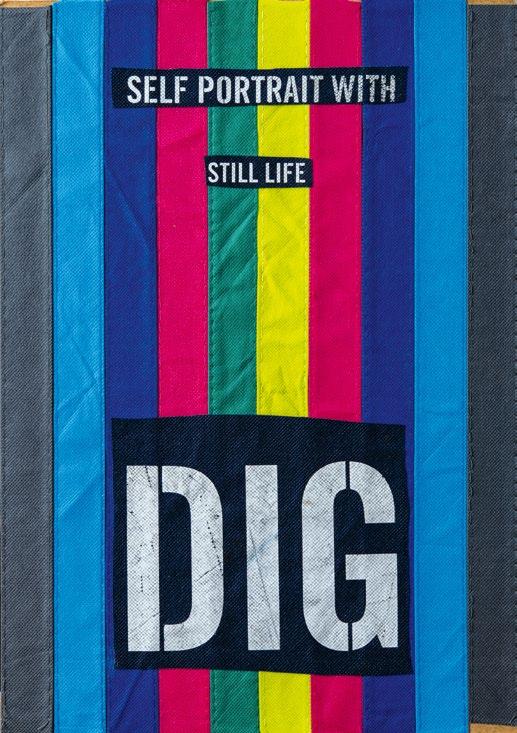

Andrew Lambirth: Collages & Drawings
20 Cork Street London W1S 3HL +44 (0)20 7734 1732 info@redfern-gallery.com redfern-gallery.com

These Fragments
I am a writer who makes collages. I do so because I love putting together previously unconnected material in new ways. It gives me a deep inner satisfaction. I love playing with colour and line and texture, and making something out of odds and ends. My career has been spent in writing about art and artists, and it is from them that I have learnt most, even when I don’t recognise a source because I absorbed it unconsciously. I owe a huge vote of thanks to them all.
I started making collages in the 1980s, sporadically at first, and then with greater regularity. What you see here is a mixture of new work and collages which have been put away for a decade or so, and come now into the spotlight for the first time. I’ve been hesitant over the years in showing my work, but the genuine enthusiasm of Richard Selby and Richard Gault of the Redfern Gallery when they saw several dozen pieces collected together gave me the courage to venture into Cork Street, where so many of my heroes have exhibited.
Although the whole show is in one sense a tribute to the art I love, it also I hope has a character of its own, which is that personal element or interpretation I bring to it. A number of these works were conceived as homages to artists and reflect my advocacy — for Robert Motherwell, Sandra Blow, Braque, Terry Frost, Kitaj, Giacometti, John Armstrong, Constable, Craigie Aitchison, Miró. Besides these acknowledged and evident references, there are numerous less overt parallels which act — at least to my mind — as friendly greetings to artists I admire. And it has to be said that the people who have encouraged me most have tended to be painters: Maggi Hambling, Eileen Hogan and Dan Coombs especially. And I’d like to place on record here my grateful thanks to Sarah Milne, who, much to my surprise and delight, invited me to make a solo exhibition at Flatford Mill.
Throughout my work there is constant dialogue with Eileen Agar, the first artist of real consequence I worked with. Although I had put together one or two amateurish collages before I met her, she made me aware of the rich potential of the medium, for she was a collagist of supreme achievement. I learnt a lot from spending time with her, collaborating on the writing of her memoirs, and later helping her to move house. She gave me a mass of collage material which she no longer needed, and these fragments have been finding their way into my collages ever since. Eileen was ruthless when it came to cutting up old books, however valuable they might now seem, and much of the obviously antique printed imagery I employ comes from this fund of cropped pages.
There are salutes to others I have worked with: to Peter Blake, for instance, another brilliant collagist, though rather a different one to Eileen. I have frequently written about his work and interviewed him, and in 1999 I curated an exhibition from his collections, which was an education in itself. I think of Peter in the blue postcard collages (such as Souvenir Affectueux), just as I raise my hat to Matisse in my pink Music Lesson. Roger Hilton, whose paintings and drawings mean so much to me and keep revealing new things, is a constant presence. Prunella Clough is another remarkable painter and printmaker who is often in my mind when I make collages. You may not see the connection, but for me it exists.
So I make collages for a variety of reasons: because I enjoy it, because I want to know more about the materials I use and how they can work together, and because I want to understand the whole business of art better — always useful for an art critic. I love the sense of discovery, the possibility of surprising myself, and the satisfaction that derives from making a new and personal order out of random elements.
There are various subjects and themes which emerge here: the great stone circle of Avebury being perhaps the most evident. This has been an abiding passion in recent years, ever since I moved to Wiltshire, though curiously enough, the first piece I made about the stones (Meditations on Avebury) dates from 2007, before the move. Other recurring subjects include islands, the human head, mountains and hills, trees, the sky and flight, still-life, the theatre, and the relationship between town and country. Language itself becomes a component in some works, and titles often evoke an extra layer of meaning.
The imagery oscillates between the organic and the more abstract and geometric. Both types involve layering, sometimes of paint, most often of paper, card, foil or found objects. Part of the fun is finding objects, whether discarded on a beach or pavement, or purchased from a junk shop or antique market. Sometimes I use photographs I’ve taken, or postcards I’ve collected, as well as all sorts of printed material. I’m not really a painter, but I like to use colour and texture, and sometimes paint is the best vehicle for this in a collage. I do try to draw, in all sorts of media, sometimes from observation, at others from memory or imagination. But collage is my preferred method of making, and it helps me both to enjoy and celebrate the world and to endure it.
Andrew Lambirth

Stone Landscape III, 2020 oil & collage 16 × 12 in (40.5 × 30.5 cm)





Avebury Stones, 2022 house-paint & collage 13¾ ×
in (35











Congruencies, 2022 house-paint & collage 14 × 16¾ in (35.5 × 42.5 cm)







